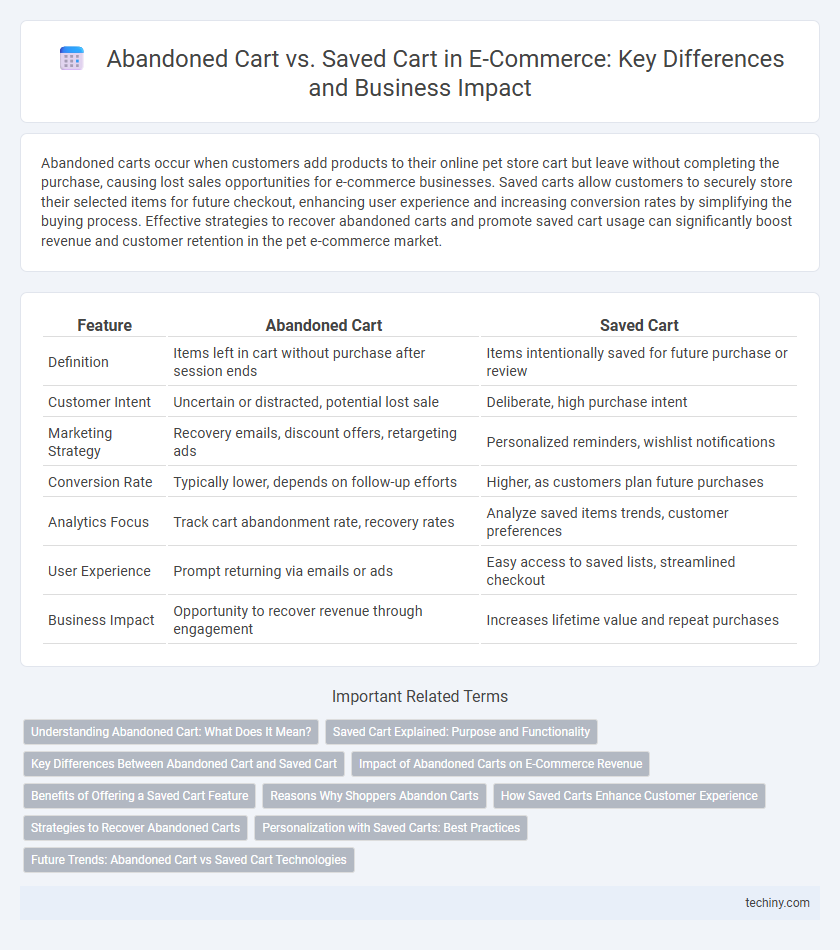Abandoned carts occur when customers add products to their online pet store cart but leave without completing the purchase, causing lost sales opportunities for e-commerce businesses. Saved carts allow customers to securely store their selected items for future checkout, enhancing user experience and increasing conversion rates by simplifying the buying process. Effective strategies to recover abandoned carts and promote saved cart usage can significantly boost revenue and customer retention in the pet e-commerce market.
Table of Comparison
| Feature | Abandoned Cart | Saved Cart |
|---|---|---|
| Definition | Items left in cart without purchase after session ends | Items intentionally saved for future purchase or review |
| Customer Intent | Uncertain or distracted, potential lost sale | Deliberate, high purchase intent |
| Marketing Strategy | Recovery emails, discount offers, retargeting ads | Personalized reminders, wishlist notifications |
| Conversion Rate | Typically lower, depends on follow-up efforts | Higher, as customers plan future purchases |
| Analytics Focus | Track cart abandonment rate, recovery rates | Analyze saved items trends, customer preferences |
| User Experience | Prompt returning via emails or ads | Easy access to saved lists, streamlined checkout |
| Business Impact | Opportunity to recover revenue through engagement | Increases lifetime value and repeat purchases |
Understanding Abandoned Cart: What Does It Mean?
An abandoned cart occurs when a customer adds products to their online shopping cart but leaves the website without completing the purchase, resulting in lost sales opportunities. Key factors contributing to cart abandonment include unexpected shipping costs, complicated checkout processes, and lack of payment options. Understanding this behavior enables e-commerce platforms to implement targeted strategies such as reminder emails, retargeting ads, and streamlined checkout flows to recover potential revenue.
Saved Cart Explained: Purpose and Functionality
Saved cart functionality enables customers to store selected items for future purchase, enhancing user experience by allowing easy access and decision-making flexibility. This feature increases conversion rates by reducing friction in the shopping process and encouraging return visits. Unlike abandoned carts, saved carts are intentional and user-driven, serving as personalized shopping reminders and facilitating seamless checkout when users are ready to buy.
Key Differences Between Abandoned Cart and Saved Cart
Abandoned carts occur when shoppers add products but leave the website without completing the purchase, often signaling potential lost revenue; saved carts involve customers intentionally saving items for future consideration, indicating higher purchase intent. Abandoned carts typically trigger automated recovery emails aimed at conversion, whereas saved carts prioritize personalized reminders or promotions to nudge completion. The key difference lies in user behavior intent, with abandoned carts reflecting interruption or indecision and saved carts representing deliberate planning or comparison.
Impact of Abandoned Carts on E-Commerce Revenue
Abandoned carts account for nearly 70% of online shopping sessions, causing significant revenue loss in e-commerce industries worldwide. By analyzing cart abandonment rates and implementing retargeting strategies, businesses can recover up to 15-30% of lost sales and enhance overall conversion rates. Optimizing abandoned cart emails with personalized content and timely reminders directly boosts customer retention and revenue generation.
Benefits of Offering a Saved Cart Feature
Offering a saved cart feature enhances customer experience by allowing users to securely store their selected items for future purchase, increasing the likelihood of conversion. This functionality reduces cart abandonment rates by providing flexibility and convenience, enabling shoppers to browse without losing progress. Retailers benefit from higher retention and personalized marketing opportunities through data on saved items, driving repeat sales and customer loyalty.
Reasons Why Shoppers Abandon Carts
Shoppers abandon carts due to unexpected shipping costs, complicated checkout processes, and lack of payment options, which increase friction during purchase. Concerns over security and unclear return policies also contribute to cart abandonment rates. Saved carts, in contrast, indicate intent to buy later, often reflecting shoppers' need for more time to compare prices or wait for discounts.
How Saved Carts Enhance Customer Experience
Saved carts improve customer experience by allowing shoppers to return to their selected items without starting over, reducing friction and increasing convenience. This feature encourages longer browsing sessions and higher conversion rates by preserving user preferences and purchase intent. By offering personalized reminders and easy access to saved items, e-commerce platforms foster customer loyalty and reduce cart abandonment rates.
Strategies to Recover Abandoned Carts
Recovering abandoned carts involves deploying personalized email reminders featuring product images and limited-time discounts to re-engage customers effectively. Implementing retargeting ads and push notifications can increase visibility and prompt users to complete their purchases. Streamlining the checkout process by reducing friction points and offering multiple payment options enhances the likelihood of cart recovery in e-commerce.
Personalization with Saved Carts: Best Practices
Personalization with saved carts boosts e-commerce conversion by tailoring product recommendations and timely reminders based on individual browsing and purchasing behavior. Utilizing customer data to customize saved cart experiences increases engagement and reduces cart abandonment rates. Implementing dynamic content, personalized discounts, and follow-up emails ensures higher recovery of saved carts compared to generic abandoned cart messages.
Future Trends: Abandoned Cart vs Saved Cart Technologies
Future trends in e-commerce highlight advancements in abandoned cart and saved cart technologies through AI-driven personalized reminders and real-time inventory updates. Enhanced integration of machine learning algorithms aims to predict customer behavior, reducing cart abandonment rates while improving saved cart utilization for seamless purchasing experiences. Emerging tools leverage predictive analytics and dynamic pricing strategies to convert abandoned carts into completed sales and optimize saved cart value.
Abandoned Cart vs Saved Cart Infographic

 techiny.com
techiny.com